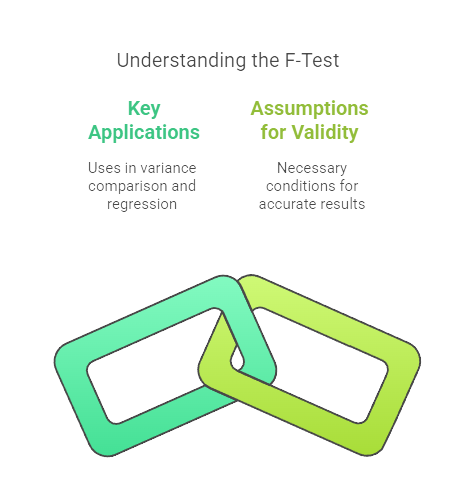Summary: The F-test is a statistical method used to compare variances between populations or assess regression model significance. It relies on the F-distribution and is widely applied in ANOVA and hypothesis testing. This guide explains its purpose, calculation steps, and applications in variance comparison and regression analysis for better decision-making.
Introduction
The F-test is a statistical method used to compare variances between two populations or assess the overall significance of a regression model. It relies on the F-distribution, a probability distribution that arises when comparing the ratios of variances.
This test is fundamental in Analysis of Variance (ANOVA), regression analysis, and hypothesis testing involving multiple groups. By evaluating whether variances are equal or if regression models improve predictions, the F-test helps researchers draw meaningful conclusions from data.
Key Takeaways
- The F-test compares population variances or evaluates regression model significance.
- It uses the F-distribution, defined by numerator and denominator degrees of freedom.
- Common applications include ANOVA and regression analysis for hypothesis testing.
- A high F-value indicates significant variance differences or model improvement.
- Adherence to assumptions ensures accurate results in F-test applications.
F-Distribution

The F-distribution is a continuous probability distribution derived from the ratio of two independent chi-square distributions. It is defined by two parameters: numerator degrees of freedom (df₁) and denominator degrees of freedom (df₂). Key properties include:
- Positively skewed: The distribution is asymmetric, with a longer tail on the right. Skewness decreases as degrees of freedom increase.
- Non-negative values: All F-values are ≥ 0, as variances (squared deviations) cannot be negative.
- Reciprocal property: Lower-tail probabilities can be derived from upper-tail values by inverting the F-statistic and swapping degrees of freedom.
The F-distribution’s shape varies with df₁ and df₂, making it adaptable to different sample sizes.
Understanding F-Test

The F-test evaluates whether two population variances are equal or if a regression model’s explanatory variables jointly improve predictions. Key applications include:
- Comparing variances: Testing if two samples originate from populations with equal variances (e.g., quality control).
- ANOVA: Determining if group means differ significantly in experiments with multiple treatments.
- Regression analysis: Assessing whether a model with additional predictors fits the data better than a simpler one.
Assumptions for validity:
- Populations are normally distributed.
- Samples are independent and randomly selected.
- Larger variance is placed in the numerator when calculating the F-statistic.
Hypothesis Testing Framework for F-Test
The F-test is a statistical method used to test hypotheses about variances or model significance. It relies on the F-distribution and compares the ratio of variances or evaluates regression models. Below is the framework for conducting hypothesis testing using the F-test:
Step 1: Define Hypotheses
- Null hypothesis (H₀): Variances are equal (σ₁² = σ₂²) or regression coefficients are zero.
- Alternative hypothesis (H₁): Variances are unequal (σ₁² ≠ σ₂²) or coefficients are non-zero.
Step 2: Calculate F-Statistic
The F-statistic is the ratio of sample variances:
where s12s12 (larger variance) is the numerator and s22s22 is the denominator.
Step 3: Determine Degrees of Freedom
- Numerator df (df₁): n1−1n1−1, where n1n1 is the sample size for the first group.
- Denominator df (df₂): n2−1n2−1, where n2n2 is the sample size for the second group.
Step 4: Find Critical Value
Using an F-distribution table, locate the critical value (FcriticalFcritical) at a chosen significance level (e.g., α = 0.05) with df₁ and df₂.
Step 5: Interpret Results
- Reject H₀ if Fcalc>FcriticalFcalc>Fcritical (variances are unequal).
- Fail to reject H₀ if Fcalc≤FcriticalFcalc≤Fcritical (variances are equal).
F Test Statistics in Regression
The F-test statistics in regression analysis is used to evaluate whether a regression model provides a statistically significant explanation of the variability in the dependent variable. It determines if the independent variables, as a group, significantly predict the dependent variable by comparing the variance explained by the model to the unexplained variance (residuals).
where SSRSSR (regression sum of squares), SSESSE (error sum of squares), kk (number of predictors), and nn (sample size).
Example:
For a regression model with SSR=120SSR=120, SSE=30SSE=30, k=3k=3, and n=50n=50:
If FcriticalFcritical at α = 0.05 is 2.82, reject H₀, indicating predictors improve the model.
Steps to Calculate an F-Test
- Formulate hypotheses: Define H₀ and H₁.
- Compute variances: Calculate s12s12 and s22s22.
- Calculate F-statistic: Use F=s12s22F=s22s12.
- Determine degrees of freedom: df₁ = n1−1n1−1, df₂ = n2−1n2−1.
- Find critical value: Refer to F-table with α, df₁, and df₂.
- Compare and conclude: Reject H₀ if Fcalc>FcriticalFcalc>Fcritical.
Example:
Sample 1 (n=10): Variance = 25
Sample 2 (n=8): Variance = 10
F=2510=2.5
df₁ = 9, df₂ = 7. At α = 0.05, Fcritical=3.68Fcritical=3.68. Since 2.5 < 3.68, fail to reject H₀3.
Conclusion
The F-test statistics is a versatile tool for comparing variances and evaluating regression models. By leveraging the F-distribution, it enables researchers to test hypotheses about population parameters and model efficacy. Proper application requires adherence to assumptions and careful interpretation of results.
Frequently Asked Questions
What is the Purpose of an F-Test?
The F-test determines if two population variances are equal or if regression predictors improve model fit. It is widely used in ANOVA and hypothesis testing.
How Does An F-Test Differ from A T-Test?
While t-tests compare means, F-tests compare variances or assess joint significance of multiple predictors in regression. F-tests are suitable for comparing more than two groups.
What Does A High F-Value Indicate?
A high F-value suggests significant differences between group variances or that a regression model explains a substantial portion of data variability. It often leads to rejecting the null hypothesis.
By integrating these concepts, researchers can apply the F-test effectively across diverse statistical scenarios.




